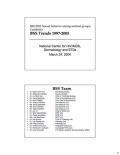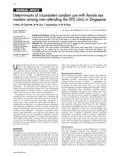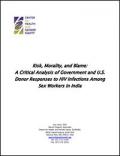What's New
Displaying results 4701 - 4710 of 4914

Resource | Presentations,
The BSS ‐ Purpose:
- Provide specific-year information on socio-demographic and risk behavior related to HIV/STDs
- Monitor sexual behavior of risk groups from year to year to determine trends in behavior change
- Provide baseline data for the three-year USAID funded provinces

Resource | Publications,
This study was conducted in order to determine the prevalence of men having sex with men (MSM) and their HIV related behaviours and attitudes among Chinese men in Hong Kong. Methods: A large scale, random, population based, anonymous telephone survey of 14 963 men between the ages of 18–60 was conducted. The overall response rate was approximately 57%.

Resource | Publications,
This report gives overviews of Life skills Education in Indonesia and Life- skills education for healthy living and HIV-AIDS prevention by Ministry of National Education (MONE) and UNICEF which is based on key document and materials reviews, interviews of key informants at the national level and field Visits and Interviews of Key Informants at selected Province, District, and School.
The World Health Organization (WHO) defines life skills as the ability of individuals to employ adaptive and positive behavior to deal effectively with the demands and challenges of everyday life (1997).

Resource | Publications,
Female sex workers and their male clients have been identified as risk groups for the transmission of STDs and HIV. Behavioural interventions targeting clients need to address inconsistent condom use among them. The aim of the study is to assess the sociodemographic, behavioural, and psychological factors associated with inconsistent condom use among clients of sex workers.

Resource | Publications,
This annotated bibliography is intended as a resource for policy makers, programme managers and other personnel working in HIV/AIDS control in developing countries. The aim of this bibliography is to provide representative examples of developing country’ experiences on the effectiveness and programmatic challenges for scaling up adult national antiretroviral treatment programmes.
Given that antiretroviral treatment in developing countries is recent, and research in the field is still emerging, the articles for which annotations are presented here not only include examples from original research, but also published viewpoints, research letters, correspondence, etc.

Resource | Publications,
A recently completed Horizons study in Thailand examined the question of how to encourage the private sector to become actively involved in developing and improving workplace HIV/AIDS programs. Researchers investigated the role of incentives in encouraging companies to adopt workplace policies and programs that address stigma and discrimination and respond to the needs of workers for information and services. The research was conducted in partnership with American International Assurance (AIA), the Thailand Business Coalition on AIDS (TBCA), and AusAID, the overseas development agency of the Australian government.
The investigators explored the process and outcomes of offering incentives to encourage companies to improve their workplace HIV/AIDS policies and programs. They hypothesized that these incentives would motivate companies to introduce or improve their policies and activities, which in turn would result in improvements in employees’ knowledge and behaviors.

Resource | Publications,
The main objective of the sentinel HIV sero-surveillance is to provide repeated measures of HIV prevalence in selected population groups in selected geographical sites to monitor levels and trends over time. Data generated by the sentinel sero-surveillance is used for HIV estimates, programme planning, and advocacy purposes.
This report summarizes the methods and results of the Sri Lankan HIV sentinel serosurveillance survey conducted in the year 2003.

Resource | Publications,
Recently, Indonesia has adopted an ambitious target of providing antiretroviral treatment (ART) to at least 10 000 people by the end of 2005. As of January 2004, of an estimated 15 000 people who were in need of ART, only 1300 persons were receiving the treatment. The intermediate target for 2005 is in line with the global WHO and UNAIDS "3 by 5" initiative. The initiative aims to provide three million people in developing countries (out of six million in need globally) access to ART by the end of 2005. The ultimate goal of the initiative is to provide universal access.
From 19 to 31 January 2004, a team of WHO experts visited Indonesia to assess the country's readiness for rapid scale-up of ART, to identify the technical support that will be needed, and to recommend urgent action towards achieving the time-bound target.

Resource | Publications,
The Paris AIDS Summit Declaration of 1994 acknowledged the central role of people living with HIV in AIDS education and care, and in the design and implementation of policies and programs towards a successful response to HIV/AIDS.
GIPA means the Greater Involvement of People with HIV/AIDS, and derives from a principle embedded in the Paris AIDS Summit Declaration of 1994. At this summit, leaders of 42 nations met together to determine how they could effectively respond to the AIDS crisis.

Resource | Publications,
India is one of five countries that—along with Russia, China, Nigeria and Ethiopia—were classified by the U.S. National Intelligence Council in 2002 as representing the second wave of the HIV/AIDS epidemic. Current estimates put the total of those infected with HIV in India at 4.5 million, with projections for the number of infections to rise to anywhere between 9 to 25 million by 2010 (NACO 2003; NIC 2002; Rao 2003). Mirroring the global trend, new infections in India are rising rapidly among women ages 15 to 49, who, in 2002, accounted for nearly 40 percent of the total number of estimated cases in the country (NACO Director, July 25, 2003). Surveillance data indicate that HIV prevalence rates among women attending antenatal clinics in several Indian states are well above one percent (NACO 2003). As is clear from these data, HIV infections in India have moved from “high-risk” populations, such as commercial sex workers, into the general population. Yet, not surprisingly, sex workers remain disproportionately affected by the epidemic in India, with prevalence rates among them ranging from 40 to 60 percent in some parts of the country.





